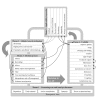Assistive Technology for the Upper Extremities After Stroke: Systematic Review of Users' Needs
- PMID: 30497993
- PMCID: PMC6293243
- DOI: 10.2196/10510
Assistive Technology for the Upper Extremities After Stroke: Systematic Review of Users' Needs
Abstract
Background: Technical innovations have the potential to compensate for loss of upper-limb motor functions after stroke. However, majority of the designs do not completely meet the needs and preferences of the end users. User-centered design methods have shown that the attention to user perspectives during development of assistive technology leads to devices that better suit the needs of the users.
Objective: To get more insight into the factors that can bring the design of assistive technology to higher levels of satisfaction and acceptance, studies about user perspectives on assistive technology for the upper limb after stroke are systematically reviewed.
Methods: A database search was conducted in PubMed, EMBASE, CINAHL, PsycINFO, and Scopus from inception to August 2017, supplemented with a search of reference lists. Methodological quality of the included studies was appraised. User perspectives of stroke survivors, carers, and health care professionals were extracted. A total of 35 descriptive themes were identified, from which 5 overarching themes were derived.
Results: In total, 9 studies with information gathered from focus groups, questionnaires, and interviews were included. Barriers and enablers influencing the adoption of assistive technology for the upper limb after stroke emerged within 5 overarching but highly interdependent themes: (1) promoting hand and arm performance; (2) attitude toward technology; (3) decision process; (4) usability; and (5) practical applicability.
Conclusions: Expected use of an assistive technology is facilitated when it has a clear therapeutic base (expected benefit in enhancing function), its users (patients and health care professionals) have a positive attitude toward technology, sufficient information about the assistive technology is available, and usability and practical applicability have been addressed successfully in its design. The interdependency of the identified themes implies that all aspects influencing user perspectives of assistive technology need to be considered when developing assistive technology to enhance its chance of acceptance. The importance of each factor may vary depending on personal factors and the use context, either at home as an assistive aid or for rehabilitation at a clinic.
Keywords: assistive technology; stroke; upper limb; user perspectives; user-centered design.
©Anne L van Ommeren, Laura C Smulders, Gerdienke B Prange-Lasonder, Jaap H Buurke, Peter H Veltink, Johan S Rietman. Originally published in JMIR Rehabilitation and Assistive Technology (http://rehab.jmir.org), 29.11.2018.
Conflict of interest statement
Conflicts of Interest: None declared.
Figures





References
-
- Go AS, Mozaffarian D, Roger VL, Benjamin EJ, Berry JD, Borden WB, Bravata DM, Dai S, Ford ES, Fox CS, Franco S, Fullerton HJ, Gillespie C, Hailpern SM, Heit JA, Howard VJ, Huffman MD, Kissela BM, Kittner SJ, Lackland DT, Lichtman JH, Lisabeth LD, Magid D, Marcus GM, Marelli A, Matchar DB, McGuire DK, Mohler ER, Moy CS, Mussolino ME, Nichol G, Paynter NP, Schreiner PJ, Sorlie PD, Stein J, Turan TN, Virani SS, Wong ND, Woo D, Turner MB, American Heart Association Statistics Committee and Stroke Statistics Subcommittee Heart disease and stroke statistics--2013 update: a report from the American Heart Association. Circulation. 2013 Jan 1;127(1):e6–e245. doi: 10.1161/CIR.0b013e31828124ad. http://circ.ahajournals.org/cgi/pmidlookup?view=long&pmid=23239837 CIR.0b013e31828124ad - DOI - PMC - PubMed
-
- Hong KS, Saver JL. Quantifying the value of stroke disability outcomes: WHO global burden of disease project disability weights for each level of the modified Rankin Scale. Stroke. 2009 Dec;40(12):3828–33. doi: 10.1161/STROKEAHA.109.561365. http://stroke.ahajournals.org/cgi/pmidlookup?view=long&pmid=19797698 STROKEAHA.109.561365 - DOI - PMC - PubMed
-
- Bots ML, Buddeke J, van Dis I, Vaartjes I, Visseren FL. Cardiovascular diseases in the Netherlands 2017 [in Dutch: Hart- en vaatziekten in Nederland 2017] 2017. https://www.hartstichting.nl/getmedia/cd75c3f5-9cd2-4558-b53c-87295bf0e6... .
-
- Van Duin C. Bevolkingsprognose 2008–2050: naar 17,5 miljoen inwoners [Demographic projections 2008-2050: to 17.5 million inhabitants] 2009. https://www.cbs.nl/NR/rdonlyres/EB986187-DFD1-4EBA-ABC2-E14A8E9B21B0/0/2... .
Publication types
LinkOut - more resources
Full Text Sources

